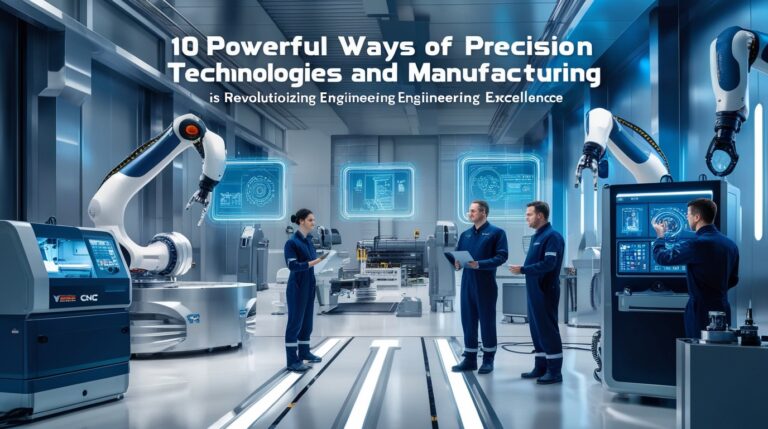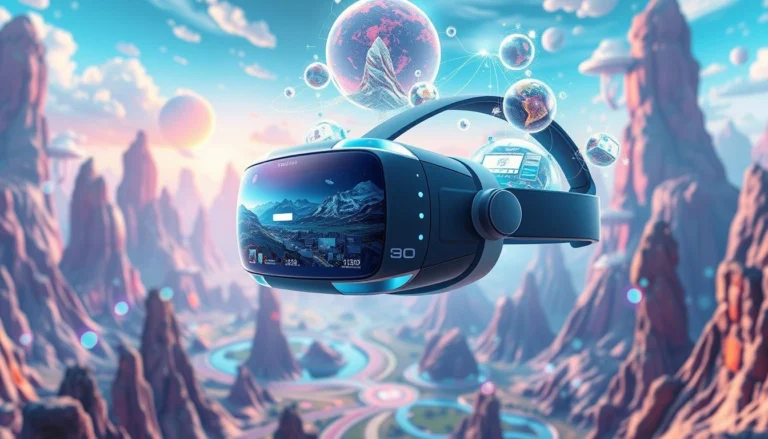Unlocking Business Growth with 2025 Tech Trends
The 2025 Tech Playbook: Navigating the Future of Digital Innovation for Business Growth
Estimated reading time: 22 minutes
Key Takeaways
- Anticipate & Leverage: Businesses must proactively anticipate and strategically leverage cutting-edge technologies—including advanced web and mobile development, AI, cloud, and DevOps—to achieve unprecedented growth and efficiency, rather than merely reacting to change.
- Performance & AI-Driven Experiences: The future of digital interaction, spanning both web and mobile, is defined by blazing speed, dynamic interactivity, and deeply personalized, AI-powered user experiences, exemplified by frameworks like Next.js and the emergence of AI smart glasses.
- Cloud-Native & DevOps Imperative: Cloud computing, particularly serverless architectures, coupled with robust DevOps practices and CI/CD automation, is fundamental for building scalable, cost-efficient, and rapidly deployable software, all while increasingly integrating sustainable computing principles.
- Smart Automation for Efficiency: AI automation is transforming business operations through intelligent chatbots, hyperautomation (powered by tools like n8n for workflow development), and embedded AI in SaaS products, enabling smart delegation, significant cost reductions, and freeing human talent for strategic initiatives.
- Human-Centric & Adaptive Design: Modern UI/UX design is focused on crafting empathetic, intuitive, and accessible digital experiences that adapt to individual users and diverse devices, incorporating new interaction paradigms like Voice User Interfaces (VUIs) and Augmented Reality (AR) to enhance engagement.
Table of Contents
- Introduction: Charting the Course for Digital Dominance in 2025
- 1. The Evolving Landscape of Web Development in 2025: Speed, Intelligence, and Immersion
- 2. Mobile App Development in 2025: Innovation, Immersion, and User-Centric Design
- 3. Cloud Computing & DevOps: Accelerating Digital Transformation
- 4. AI Automation for Businesses: Smart Delegation and Efficiency
- 5. Modern UI/UX Design: Crafting Seamless Digital Experiences
- 6. Digital Transformation Strategies for Growth in 2025: A Holistic Approach
- Frequently Asked Questions (FAQs)
- Conclusion: Pioneering Your Path to Digital Success in 2025
Introduction: Charting the Course for Digital Dominance in 2025
The year 2025 isn’t just another calendar mark; it’s a pivotal point in the digital evolution, a landscape redefined by relentless innovation and strategic technological adoption. Businesses that thrive in this era won’t merely react to change; they will anticipate, integrate, and leverage cutting-edge solutions to unlock unprecedented growth and efficiency. From the dynamic shifts in web and mobile application development to the transformative power of AI automation and the foundational robustness of cloud computing and DevOps, every sector is experiencing a profound overhaul.
This comprehensive guide serves as your essential 2025 tech playbook, distilling complex trends into actionable insights. Whether you’re a business owner aiming for market leadership, a developer architecting the next generation of digital products, or a tech enthusiast eager to understand what’s next, this article will illuminate the path forward. We’ll explore how today’s advancements in web development trends, mobile app development 2025, cloud computing and DevOps, AI automation for businesses, and modern UI/UX design are not just theoretical concepts but tangible tools for accelerating growth, improving performance, and fundamentally transforming operations.
At AITechScope, we stand at the forefront of this revolution. As a leading provider of virtual assistant services, specializing in AI-powered automation, n8n workflow development, and business process optimization, we empower companies to harness these advancements. Our mission is to help businesses scale operations, reduce costs, and improve efficiency through intelligent delegation and automation solutions. Join us as we dive deep into the trends shaping 2025 and beyond, equipping you with the knowledge to lead the charge in the digital age.
1. The Evolving Landscape of Web Development in 2025: Speed, Intelligence, and Immersion
Web development in 2025 is a testament to the pursuit of speed, intelligence, and deeply immersive user experiences. The era of static, slow-loading websites is long gone, replaced by a demand for dynamic, AI-powered applications that respond instantly and anticipate user needs. These web development trends are not just about aesthetics but about core functionality and business impact.
1.1 Beyond Static Pages: Interactive & AI-Powered Web Experiences
The future of the web is inherently interactive and intelligent. Users expect more than just information; they demand engagement, personalization, and seamless journeys. This pushes developers towards creating rich, dynamic interfaces that feel less like websites and more like applications.
The integration of artificial intelligence is paramount, giving rise to truly AI-powered web apps. From AI-driven content recommendations and personalized user journeys to dynamic UI adjustments based on user behavior and even generative AI for design elements, AI is becoming an invisible co-pilot in the user experience. Imagine a website that automatically optimizes its layout for an individual user based on their past interactions, or an e-commerce platform that curates product displays with uncanny precision. This level of intelligent design and functionality is no longer a luxury but a growing expectation.
1.2 Performance and Scalability: The Next.js Advantage
In an age where every millisecond counts, web performance is not just an optimization; it’s a competitive differentiator. Slow load times lead to high bounce rates, poor conversion, and damaged SEO. This is where frameworks like Next.js shine, delivering unparalleled Next.js and React performance.
Next.js, built on React, enables developers to create incredibly fast, SEO-friendly, and scalable web applications through features like server-side rendering (SSR), static site generation (SSG), and incremental static regeneration (ISR). These capabilities ensure that content is delivered quickly, even on slow connections, leading to superior user experiences and improved search engine rankings.
For small businesses, Next.js offers a powerful pathway to a modern, high-performing online presence. It simplifies complex web development tasks, making it possible to build a fast marketing site in one weekend. A Next.js small business site isn’t just quick to launch; it’s designed for growth, easily integrating with various APIs and services without sacrificing speed. Resources like a Next.js beginner guide are readily available, making this powerful framework accessible even to those with limited prior experience. The promise of a fast marketing site Next.js delivers is real, impacting everything from lead generation to brand perception.
Furthermore, optimizing React applications is critical. Simple fixes can yield significant results. As highlighted in a real-world case study, performance optimization techniques like lazy loading images, code splitting, and memoization can reduce page load by 60% and shave seconds off load times. These performance optimization techniques are no longer optional but essential components of any modern web project.
1.3 The Power of Decoupled Architectures: Headless CMS and Micro Frontends
The monolithic web application is giving way to more flexible, modular architectures, especially with the rise of the headless CMS WordPress and microservices architecture.
A headless CMS, such as a decoupled WordPress setup, separates the content management backend from the frontend presentation layer. This allows content to be delivered to any device or platform (websites, mobile apps, smart displays) via APIs, offering immense flexibility and future-proofing. For businesses seeking WordPress without the bloat, adopting a headless approach with lightweight plugins can significantly help SEO and performance, providing a streamlined content delivery system that is both robust and agile.
Similarly, micro frontends extend the microservices concept to the frontend. Instead of building a single, large frontend, teams can develop and deploy smaller, independent frontends for specific features or sections of an application. This approach improves scalability, allows for independent team development, and reduces the risk of a single point of failure. While micro frontends offer benefits, it’s crucial to understand when they help and when they hurt, requiring careful planning and execution.
These decoupled architectures contribute to a robust tech stack for modern businesses, allowing for greater agility, easier scaling, and the ability to integrate specialized tools more effectively.
1.4 Progressive Web Apps (PWAs) and Server-Side Rendering (SSR)
Progressive Web Apps (PWAs) continue their ascent, blurring the lines between native mobile apps and traditional websites. PWAs offer app-like experiences directly from the browser, including offline capabilities, push notifications, and home screen installation, making them a powerful tool for extending reach without the overhead of app store submissions.
Server-Side Rendering (SSR), a core feature of frameworks like Next.js, renders pages on the server before sending them to the browser. This dramatically improves initial page load times and enhances SEO, as search engine crawlers can easily index fully rendered content. Both PWAs and SSR are critical components in delivering the fast, reliable, and engaging web experiences users expect in 2025.
2. Mobile App Development in 2025: Innovation, Immersion, and User-Centric Design
Mobile devices remain the primary gateway to the digital world for billions, making mobile app development 2025 a fiercely competitive and rapidly innovating sector. The trends point towards cross-platform efficiency, deeper AI integration, and a push for highly immersive and context-aware user experiences, including the emergence of new form factors.
2.1 Cross-Platform Dominance: Flutter vs. React Native in 2025
The debate over Flutter vs React Native continues to be central for businesses looking to build cost-effective and efficient mobile applications. Both frameworks offer the ability to develop a single codebase that deploys to both iOS and Android, significantly reducing development time and resources compared to native development.
In React Native vs Flutter 2025, both have matured considerably. React Native, backed by Meta, leverages JavaScript and React, making it popular among web developers transitioning to mobile. Flutter, powered by Google, uses Dart and offers superior UI rendering capabilities and performance closer to native, often preferred for its beautiful, custom designs.
For startups and small businesses, the choice of which mobile framework for startups hinges on factors like existing team skill sets, budget, and the specific design and performance requirements of the app. Flutter, with its “Build a Simple Cross-Platform App with Flutter: From Idea to Play Store” approach, is often lauded for its rapid development cycle and consistent UI across platforms, making it an attractive option for quickly bringing an idea to market.
Both frameworks are continuously evolving, adding new features, improving performance, and expanding their ecosystems. The decision often comes down to specific project needs and the comfort level of the development team.
2.2 Immersive Experiences and Wearable Tech
Mobile apps are no longer confined to smartphone screens. The rise of wearables, especially AI smart glasses, is opening new frontiers for interaction. Recent developments indicate that “Harvard dropouts to launch ‘always on’ AI smart glasses that listen and record every conversation,” pushing the boundaries of what mobile technology can do. These devices, equipped with advanced AI, can offer real-time information, context-aware assistance, and hands-free interaction, fundamentally altering how we consume and interact with digital content.
This shift demands a rethinking of mobile app UI trends. Designers must consider not just screen size but also voice commands, gesture controls, and augmented reality (AR) overlays. Immersive experiences, whether through AR filters in social media apps or interactive 3D product views in e-commerce, are becoming standard. Apps are evolving to understand their environment and users’ contexts better, providing proactive, personalized assistance.
2.3 AI Integration in Mobile Apps
AI is not just an underlying technology; it’s a feature that directly enhances user experience in mobile apps. From intelligent personal assistants and predictive text input to advanced image recognition and personalized content feeds, AI makes mobile apps smarter and more intuitive.
Think of mobile banking apps using AI for fraud detection, health apps providing personalized wellness advice based on biometric data, or navigation apps offering real-time traffic predictions. As AI models become more compact and efficient, more processing can happen directly on the device, improving speed and privacy. This deep integration of AI is what drives truly intelligent mobile solutions in 2025.
3. Cloud Computing & DevOps: Accelerating Digital Transformation
The twin pillars of cloud computing and DevOps are indispensable for any organization embarking on digital transformation strategies. In 2025, they are less about isolated technologies and more about a holistic approach to building, deploying, and managing software with unprecedented speed, reliability, and scalability.
3.1 The Cloud-Native Imperative: Beyond Migration
Simply moving existing applications to the cloud, a cloud migration strategy, is no longer sufficient. While “How to Move Your Legacy App to the Cloud Without Breaking It” provides valuable guidance for initial steps, the future lies in embracing cloud-native architectures. This means designing applications specifically to leverage the elastic, distributed, and resilient nature of the cloud.
A cornerstone of this shift is serverless architecture. This paradigm allows developers to build and run applications and services without managing servers. Cloud providers automatically provision, scale, and manage the infrastructure. For instance, “Serverless on AWS: Create a Cost-Efficient Backend That Scales Automatically” demonstrates how serverless functions can significantly reduce operational overhead and costs. A serverless AWS cost example often highlights the pay-per-execution model, leading to substantial savings for serverless backend for startups and small businesses, as they only pay for the compute resources consumed, not for idle servers. This inherent scalability and cost-efficiency make serverless an attractive option for modern applications.
3.2 DevOps as a Culture: Streamlining Development and Operations
DevOps best practices transcend tools and technologies; they represent a cultural shift that breaks down silos between development and operations teams. The goal is to foster collaboration, communication, and automation throughout the entire software development lifecycle.
Central to DevOps is CI/CD automation (Continuous Integration/Continuous Delivery). CI/CD pipelines automate the process of building, testing, and deploying code changes, allowing teams to deliver software faster and more reliably. For CI CD small team environments, tools like GitHub Actions are invaluable. A GitHub Actions deploy tutorial can quickly get small teams up and running with automated deployments, significantly reducing manual errors and freeing up developers to focus on innovation rather than repetitive deployment tasks. This automation is crucial for maintaining agility and responsiveness in a fast-paced market.
3.3 The Rise of Green Computing and Sustainable AI Infrastructure
As technology adoption expands, so does its environmental footprint. In 2025, there’s a growing emphasis on green computing and building sustainable infrastructure, particularly for resource-intensive operations like AI. The development of large AI models and data centers requires immense energy.
A significant trend is the push for renewable energy sources to power these facilities. For example, “Meta to add 100MW of solar power from US gear” for a new AI data center in South Carolina, underscores the industry’s commitment to mitigating its environmental impact. This focus on sustainability extends beyond energy consumption to optimizing code for efficiency, choosing greener data centers, and even designing algorithms that are less energy-intensive. Businesses are increasingly recognizing that sustainable practices are not just ethical but also contribute to long-term operational resilience and brand reputation.
4. AI Automation for Businesses: Smart Delegation and Efficiency
Artificial intelligence is no longer a futuristic concept; it’s a pervasive force driving AI automation for businesses across every sector. From mundane repetitive tasks to complex decision-making, AI is becoming the engine for smart delegation, unparalleled efficiency, and innovative service delivery.
4.1 Beyond Simple Chatbots: Intelligent Conversational AI
The evolution of conversational AI has moved far beyond rudimentary rule-based systems. In 2025, chatbot automation is sophisticated, context-aware, and capable of handling complex interactions. These AI chatbots for customer service are not just answering FAQs; they are resolving issues, personalizing recommendations, and seamlessly escalating to human agents when necessary, acting as intelligent first responders.
Case studies reveal how small businesses use chatbots to save time by automating appointment scheduling, lead qualification, and basic support inquiries, freeing up staff for more complex tasks. “Real Workflows That Work” demonstrate how these tools provide 24/7 support, enhancing customer satisfaction and operational efficiency.
Furthermore, advancements in voice AI, exemplified by ElevenLabs, are transforming content creation. “ElevenLabs now lets authors create and publish audiobooks on its own platform,” utilizing AI-generated voices. This indicates a future where AI handles voice narration, translation, and even voice-activated interfaces, making content more accessible and production more efficient. This technology also underpins the growing sophistication of voice user interfaces (VUIs) in various applications.
4.2 Workflow Automation and Hyperautomation
The true power of AI lies in its ability to orchestrate and optimize entire workflows. Workflow automation tools, especially when combined with AI, are enabling hyperautomation – the end-to-end automation of business processes. This means automating repetitive tasks, integrating disparate systems, and making data-driven decisions without human intervention.
AITechScope specializes in this domain, leveraging n8n workflow development to create intelligent, custom automation solutions. We help businesses automate repetitive tasks with No-Code Tools + AI, which can save 5–10 hours/week per employee, translating into significant cost reductions and increased productivity. By optimizing workflows, businesses can scale operations more effectively, reduce errors, and free up human talent for strategic initiatives. This is a core component of business process optimization.
4.3 Embedding AI into SaaS Products and Digital Innovation for Startups
AI is no longer an add-on; it’s being natively embedded into SaaS product optimization. Developers are creating AI-powered web apps that learn and adapt, providing personalized experiences and proactive insights. “Make Your SaaS Smarter: 3 Low-Effort AI Features That Delight Users” highlights simple yet impactful ways to integrate AI, such as intelligent search, personalized dashboards, and predictive analytics, to enhance user satisfaction and stickiness.
For digital innovation for startups, AI offers a competitive edge, allowing lean teams to punch above their weight. Startups can leverage AI for market analysis, customer segmentation, automated marketing campaigns, and streamlined product development, enabling rapid iteration and growth. This focused application of AI is critical for gaining traction in competitive markets.
4.4 Real-World AI Applications: From Safety to Content Creation
AI’s impact stretches across diverse sectors, proving its versatility. In public safety, “Obvio’s stop sign cameras use AI to root out unsafe drivers,” demonstrating how computer vision and AI analytics can make streets safer. These smart cameras detect violations and analyze traffic patterns without creating a “panopticon,” balancing safety with privacy concerns.
Simultaneously, the content creation industry is being revolutionized. Beyond audiobooks, AI assists with generating draft content, summarizing lengthy documents, and translating materials, democratizing content production and expanding reach.
However, with the rapid advancement of AI, discussions around the ethical implications of AI become increasingly important. Considerations like data privacy (especially with devices like always-on smart glasses), algorithmic bias, and job displacement are critical aspects that need to be addressed as these technologies become more integrated into daily life and business operations. A responsible approach to AI development and deployment is paramount.
5. Modern UI/UX Design: Crafting Seamless Digital Experiences
User Interface (UI) and User Experience (UX) design are the architects of digital interaction. In 2025, modern UI/UX design goes beyond aesthetics; it’s about crafting empathetic, intuitive, and accessible experiences that delight users and drive engagement. The focus is on seamlessness, personalization, and inclusivity across an ever-expanding array of devices.
5.1 Human-Centric Design Principles
At the heart of modern UI/UX is a deep understanding of human behavior and needs. Human-centric design principles prioritize empathy, ensuring that interfaces are not only easy to use but also genuinely helpful and enjoyable. This involves extensive user research, usability testing, and iterative design processes.
Accessibility is a non-negotiable aspect of this approach. Designing for inclusivity means ensuring that products are usable by people with diverse abilities. Simple considerations, like “Designing Accessible Buttons: A Non-Designer’s Guide (Figma Tips),” can make a profound difference, ensuring that color contrast, target sizes, and focus states are optimized for everyone. An accessible design is not just a regulatory requirement; it’s a moral imperative and a business advantage, broadening market reach.
5.2 Personalized and Adaptive Interfaces
Leveraging data and AI, modern UI/UX creates interfaces that adapt to individual users. This personalization goes beyond displaying a user’s name; it involves dynamically adjusting content, layout, and even navigation paths based on past interactions, preferences, and real-time context.
Think of e-commerce sites that rearrange product categories based on your browsing history, news apps that curate articles tailored to your interests, or enterprise dashboards that highlight the most relevant data points for a specific role. This level of adaptation makes digital products feel more intuitive and powerful, enhancing user engagement and efficiency.
5.3 The Rise of Voice User Interfaces (VUIs) and Augmented Reality (AR) in UX
The way users interact with technology is diversifying. Voice User Interfaces (VUIs) are becoming increasingly sophisticated, driven by advancements in natural language processing and voice AI (like ElevenLabs). Users are increasingly comfortable using voice commands for navigation, data input, and task completion, especially in hands-free scenarios or with smart devices. UX designers must now consider conversational flows and auditory feedback as integral parts of the user journey.
Similarly, Augmented Reality (AR) is moving from novelty to practical utility, particularly in mobile app UI trends. AR overlays digital information onto the real world, creating immersive and interactive experiences. Whether it’s trying on clothes virtually, visualizing furniture in your home before purchase, or interactive navigation overlays, AR offers new dimensions for user engagement that designers are actively exploring. This is especially relevant with the advent of always-on AI smart glasses, which bring AR directly into the user’s field of vision.
5.4 Responsive and Inclusive Design
With the proliferation of devices—from smartwatches and smartphones to tablets, desktops, and even smart displays—responsive UI design is more critical than ever. Interfaces must fluidly adapt to different screen sizes, orientations, and input methods without compromising functionality or user experience.
Beyond responsiveness, inclusive design ensures that interfaces are usable and enjoyable by the broadest possible audience, including those with disabilities. This involves thoughtful consideration of color, typography, contrast, navigation structures, and assistive technology compatibility, leading to a more equitable and effective digital world for everyone.
6. Digital Transformation Strategies for Growth in 2025: A Holistic Approach
Digital transformation in 2025 is not merely about adopting new technologies; it’s a strategic imperative that redefines business models, operational processes, and customer engagement. It requires a holistic approach that integrates technology with people and culture to achieve sustained growth and competitive advantage.
6.1 Strategic Planning: Beyond Technology Adoption
True digital transformation strategies go beyond simply buying new software or migrating to the cloud. It involves a fundamental rethinking of how a business operates, serves its customers, and creates value. This requires clear strategic planning, defining measurable objectives, and understanding the overarching vision for the digital future.
Organizations must assess their existing infrastructure, identify pain points, and then strategically integrate technologies like AI, cloud, and modern development practices. It’s about building a roadmap that aligns technological investments with business goals, ensuring that every digital initiative contributes to the bottom line.
6.2 Empowering Small Businesses and Startups
While large enterprises often have vast resources for digital transformation, tech innovation for small businesses and digital innovation for startups is equally crucial. In fact, smaller, more agile organizations can often adapt faster. The key is to implement digital transformation on a budget.
As outlined in “7 Steps Small Companies Can Start Today,” this includes adopting cost-effective cloud services, leveraging affordable automation tools, focusing on lean development methodologies (like building a fast marketing site Next.js), and strategically using AI for customer service (how small businesses use chatbots). These steps enable small businesses to compete effectively, scale efficiently, and punch above their weight in the digital arena. A targeted approach, focusing on quick wins and iterative improvements, can yield significant returns without overwhelming resources.
6.3 Overcoming Challenges: Talent, Data, and Culture
Digital transformation is not without its hurdles. One of the biggest challenges is the talent gap – finding and retaining skilled professionals in areas like AI, DevOps, and cloud architecture. Companies must invest in upskilling their existing workforce and fostering a culture of continuous learning.
Effective data management and analytics are also critical. Businesses must be able to collect, store, process, and analyze vast amounts of data to derive meaningful insights and drive intelligent automation. Without a robust data strategy, even the most advanced AI tools will fall short.
Finally, organizational culture plays a pivotal role. Resistance to change, siloed departments, and a lack of leadership buy-in can derail digital initiatives. Fostering a culture of innovation, collaboration, and experimentation is essential for successful enterprise digital adoption.
6.4 AITechScope’s Role in Accelerating Your Digital Journey
At AITechScope, we understand these challenges and opportunities. We are dedicated to helping businesses navigate the complexities of 2025’s tech landscape. Our expertise in AI-powered automation, n8n workflow development, and business process optimization provides tailored solutions that directly address your needs.
Whether you’re looking to implement CI/CD automation for your small team, optimize your SaaS product optimization with AI, migrate to a serverless backend for startups, or simply identify the best tech stack for modern businesses, AITechScope is your strategic partner. We enable intelligent delegation and automation solutions, empowering you to scale operations, reduce costs, and improve efficiency, ensuring you are not just keeping pace with change, but leading it.
Frequently Asked Questions (FAQs)
Q1: What are the most significant 2025 tech trends for businesses?
The most significant 2025 tech trends for businesses include:
- AI-powered automation and hyperautomation across workflows and customer service.
- Advanced web development trends focusing on performance (e.g., Next.js), AI integration, and headless architectures.
- Evolution of mobile app development 2025 towards cross-platform efficiency (Flutter/React Native) and immersive experiences (AI smart glasses).
- Deep adoption of cloud computing and DevOps practices, including serverless architecture and robust CI/CD pipelines.
- Modern UI/UX design emphasizing human-centricity, personalization, and accessibility across diverse devices.
Q2: How can AI automation for businesses improve efficiency?
AI automation for businesses improves efficiency by automating repetitive tasks, optimizing workflows (e.g., via n8n workflow development), enhancing decision-making with data-driven insights, and providing 24/7 customer support through advanced AI chatbots for customer service. This frees up human employees to focus on strategic, creative, and complex problem-solving tasks, significantly reducing operational costs and accelerating business processes.
Q3: Which is better for mobile app development in 2025: Flutter vs React Native?
The choice between Flutter vs React Native in 2025 depends on your specific needs. Both are excellent choices for cross-platform mobile app development 2025.
- Flutter often provides more consistent UI across platforms and near-native performance, ideal for highly customized designs and a single development team.
- React Native leverages JavaScript, making it suitable for teams with existing web development expertise in React, and offers a vast ecosystem of libraries.
For startups, consider your existing tech stack, team skills, and the specific performance and UI requirements to determine which mobile framework for startups is best.
Q4: What are DevOps best practices for small teams?
For a CI CD small team, DevOps best practices focus on automation and collaboration. Key practices include:
- Implementing CI/CD automation from the outset (e.g., using a GitHub Actions deploy tutorial for automated builds and deployments).
- Adopting version control for all code and infrastructure.
- Prioritizing infrastructure as code (IaC).
- Fostering strong communication between development and operations.
- Utilizing cloud-native services and serverless architecture to minimize operational overhead and reduce costs (serverless AWS cost example).
Q5: How can Next.js benefit a small business site?
Next.js offers significant benefits for a Next.js small business site, including:
- Superior performance and SEO: Built-in optimizations like server-side rendering (SSR) and static site generation (SSG) ensure fast loading times, which is critical for search engine rankings and user experience.
- Rapid development: It allows developers to build a fast marketing site in one weekend due to its streamlined development experience and excellent developer tooling.
- Scalability: It’s designed to grow with your business, easily handling increased traffic and feature additions.
- Beginner-friendly: With resources like a Next.js beginner guide, it’s accessible for those new to modern web development.
Q6: What is serverless architecture and how does it reduce costs?
Serverless architecture is a cloud execution model where the cloud provider dynamically manages the allocation and provisioning of servers. Developers write and deploy code without worrying about the underlying infrastructure. It significantly reduces costs because:
- Pay-per-execution: You only pay for the actual compute resources consumed when your code runs, rather than paying for idle servers that are always on (serverless AWS cost example).
- No server management: It eliminates the operational overhead and costs associated with maintaining, patching, and scaling servers.
- Automatic scaling: Resources automatically scale up or down based on demand, preventing over-provisioning and ensuring optimal resource utilization, making it ideal for a serverless backend for startups with fluctuating traffic.
Q7: How can AITechScope help my business adopt these digital transformation strategies?
AITechScope specializes in helping businesses adopt these digital transformation strategies through:
- AI-powered automation: Implementing intelligent solutions for various business processes.
- n8n workflow development: Creating custom, efficient automation workflows to streamline operations and save 5-10 hours/week on repetitive tasks.
- Business process optimization: Analyzing and enhancing existing processes for maximum efficiency and cost reduction.
- Strategic guidance: Advising on the best tech stack for modern businesses, cloud migration strategies, and effective digital adoption to accelerate growth and improve performance. We provide intelligent delegation and automation solutions to future-proof your business.
Conclusion: Pioneering Your Path to Digital Success in 2025
The year 2025 stands as a remarkable epoch in the digital age—a time when technological advancements are not just incremental but truly transformative. From the blazing speeds of Next.js and React performance in web development to the dynamic possibilities of mobile app development 2025 using Flutter and React Native, and the foundational strength of cloud computing and DevOps paradigms, businesses have an unprecedented arsenal of tools at their disposal. The pervasive intelligence of AI automation for businesses, especially through smart chatbots and hyperautomation, is reshaping efficiency, while modern UI/UX design ensures that every digital interaction is intuitive, inclusive, and deeply engaging.
Embracing these 2025 tech trends is no longer a choice but a strategic imperative. Digital transformation is an ongoing journey that demands agility, foresight, and a willingness to innovate. It’s about leveraging these powerful technologies not just to keep pace but to set the pace—to create new value, reach new customers, and optimize every facet of your operation. Whether you’re a startup seeking to disrupt, a small business aiming for efficient growth, or a large enterprise driving widespread enterprise digital adoption, the principles outlined in this playbook provide a clear roadmap.
At AITechScope, we are more than just service providers; we are your partners in this exciting digital odyssey. Our expertise in AI-powered automation, n8n workflow development, and business process optimization is designed to empower your business to harness these cutting-edge technologies effectively. We believe that through intelligent delegation and robust automation solutions, any company can unlock its full potential, reduce costs, and achieve unparalleled efficiency.
Don’t let the future simply happen to you; actively shape it. The opportunities in 2025 are immense for those ready to embrace the power of innovation. Reach out to AITechScope today and let us help you transform your vision into a digital reality, ensuring your business is not just relevant but leading the charge in the years to come.







